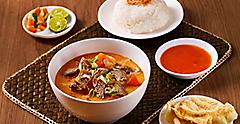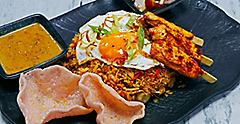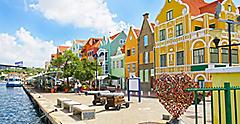The History Of Indonesian Food In Caribbean Cuisine
Famous Indonesian Food for Every Palate
By Chantae Reden | Published on July 8, 2025
Famous Indonesian food like soto is known for mouthwatering flavor combinations — but its history is just as flavorful. Join me on a dive into the fascinating history of Indonesian food and its surprising influence on the dishes we know and love in the Caribbean. From the Dutch colonial era to the present day, discover how Indonesian spices and recipes made their way across the globe, leaving an indelible mark on the culinary landscape of islands like Aruba, Bonaire and Curaçao. Get ready to explore a world of sate, soto, gado gado, nasi goren, and more, as we uncover the delicious secrets behind this unexpected culinary connection — and how you can experience all that and more on a Royal Caribbean cruise.
Key Takeaways: The Food Of Indonesia
- Indonesian cuisine blends sweet, sour, salty and spicy flavors in every bite.
- Signature dishes include nasi goreng, rendang, gado gado, sate and soto.
- Dutch colonization helped bring Indonesian food to Caribbean islands like Aruba and Curaçao.
- Explore our cruises to taste these flavors on your next Caribbean voyage.
What Is The Typical Food In Indonesia?
What is Indonesian food? Typical Indonesian food is a cuisine bursting with flavor and shaped by rich cultural history, including centuries of trade, colonization and migration across its 6,000 inhabited islands. With influences from India, China, the Middle East and the Dutch, dishes like nasi goreng and satay have become globally iconic.
Examples of famous Indonesian food include:
- Nasi Goreng: Indonesia’s iconic fried rice, cooked with sweet soy sauce, chilli and a fried egg.
- Satay: Skewered, grilled marinated meats served with Indonesia’s famous rich, spicy peanut sauce.
- Rendang: Slow-cooked beef curry, packed with spices and coconut milk, famously tender and flavorful.
- Gado-Gado: A mixed vegetable salad topped with tofu, egg and creamy, spicy peanut dressing.
- Soto Ayam: Fragrant chicken noodle soup with turmeric broth, shredded chicken, egg and crispy shallots.
- Martabak Manis: A thick, sweet pancake smothered with butter, chocolate, peanuts and condensed milk.
What Is The History Of Indonesian Food?
The history of Indonesian food began with 3,500 years of rice paddies and spices. The classic flavors got an international twist when Dutch colonizers moved in, eventually bringing Indonesian food to the Caribbean and beyond. Merchants, missionaries, and colonizers crossed through Indonesia's waters, swapping spices and seeds at marketplaces and introducing new cooking methods in the kitchen. Some of Indonesia's iconic sauces feature chiles originally from Mexico and peanuts from the Americas.
In the late 1500s, Dutch traders ventured to the Indonesian islands of Maluku and returned with spices like cloves, mace, and nutmeg. These expeditions were so lucrative, that the islands were deemed "The Spice Islands," and by the early 1600s, the Dutch East India Company (VOC) established a trading post on Java, Indonesia.
Dutch colonizers embraced Indonesian cuisine and used the diversity of dishes to impress visiting nobles and merchants. Heaps of steaming rice would be laid on a table alongside dishes from all throughout the archipelago, creating an indulgent meal called rijsttafel, or "rice table."
How Indonesian Cuisine Traveled To The Caribbean



Must-Try Indo-Caribbean Food
When it comes to Indo-Caribbean food, you don’t want to miss out on sambal, skewers or soto. You can enjoy these dishes on their own or as components of a shared meal. If you need to fuel your foodie vacation with something more nourishing, the rendang curry or nasi goreng are celebrated staples across both regions. And if you want an array of flavors that reflect the best of both worlds, there’s always a rijsttafel.
Hot Sambal Sauce
Sambal is the condiment of choice in Indonesia, a relish typically made from an aromatic blend of chiles, shrimp paste, garlic, shallots, sugar, and lime juice. The magic of sambal is that it goes well with just about every Indonesian dish, even adding pep to plain rice. I recommend sampling a small taste of the relish first, as spice levels range from barely an ember to pure fire.

Skewers: Charred And Saucy
Skewers are grilled chunks of meat served on sticks. Traders from the Middle East introduced them to Indonesia, and locals adapted the dish by marinating meat or tempeh in a sweet soy sauce or peanut sauce, grilling it over charcoal, serving it on a bed of rice and calling it satay. Portable, filling, and delicious, the satay skewer is famous Indonesian food you'll find it on the menu at most Indonesian restaurants in the Caribbean.

Spicy Soto Soup
Dive into a cozy bowl of soto, a hearty soup made with meat, vegetables, spices, and broth. Soto recipes vary greatly, and chefs often hold their secret family spice combinations close to their hearts.
Don’t forget to dig into a steamy bowl of soto ayam made with shredded chicken, boiled egg, fresh cabbage, scallions, a squeeze of lime, ginger, and fried onions. Soto betawi is made with beef and potatoes stewed with coconut milk, kaffir lime leaves, garlic, ginger chiles, scallions, and a dash of sweet soy sauce.

Rendang: Slow-Cooked Beef
What is rendang? It’s traditionally beef simmered in a sauce made of coconut milk and spieces. The beef is cooked for a long time until the sauce dissipates, leaving a dry and heavily flavored meat.
Gado Gado: Tasty Vegetarian Option
Indonesian gado gado is one of the most popular vegetarian meals in the area. Seasonal fresh vegetables are blanched and served alongside fried tempeh, tofu, or eggs, all smothered in a sweet peanut sauce and garnished with crispy fried onions or crushed peanuts.
Nasi Goreng: The Unofficial “Comfort” Indo Caribbean Food
What is nasi goreng? It’s a type of Indonesian fried rice, where the rice is wok fried with vegetables, meat, and egg and typically served as one large scoop with a fried egg on top. Swirl a spoonful of sambal or two into the rice for an extra kick. Order mie goreng to savor the same dish with egg noodles in lieu of fried rice.
Can’t Decide? Go For The Rijsttafel
If every menu item sounds too good to be true, opt for the rijsttafel to sample dishes simmering with an array of flavors. The chef decides which dishes are worthy of being featured, and you'll enjoy small plates of the restaurant's best Indonesian food served alongside a bed of steamed white rice.
Book Now
Where To Try The Best Indonesian Food In The Caribbean

While many of the islands in the region offer exciting Indonesian fare, let your tastebuds lead the way to the islands with a strong Dutch-Indonesian influence, like Aruba, Bonaire and Curaçao, to name a few.
- Aruba: Aruba is one of the best places to eat in the Caribbean if you have a penchant for spice. Try gado gado and soto at Indo, a restaurant known for heaping plates and vegan options upon request, or Café Restaurant Yanti for satay sandwiches and steamed vegetables.
- Bonaire: For a taste of fresh ingredients, stop by Roos Surinam Food, known for delicious rice and roto meals.
- Curaçao: On Curaçao, Lindhuis Daniel serves up Indonesian food culture in an authentic atmosphere, making it a must-visit while on your island foodie vacation. Their rijsttafel is best enjoyed by at least two people and comes with five select Indonesian dishes.

Try Indonesian Food on a Caribbean Cruise
While there are seemingly infinite variations of ways to cook the same dish throughout Indonesia — and each region will tell you their recipe is the right one — there are some meals you should not pass up, no matter where you find them. Indo-Caribbean food tells a story of movement, migration and the stubborn, beautiful way cultures leave their mark on each other. From the kitchens of Java to seaside markets in Curaçao, these dishes carry history in every mouthful, blending with local ingredients and new ideas along the way.
And if you’re lucky enough to be cruising through the Caribbean, you’ll spot those same spice-laden, coconut-rich flavors popping up on plates from Bali to Barbados. Explore Royal Caribbean Cruises today to kick off your own mouthwatering adventure.
Get Royal Deals, Sign Up Today
Related Articles

How to Plan a Cruise for the First Time
READ MORE

Special Occasion Cruise Planning
READ MORE

How to Use Cruise Deck Plans
READ MORE

7 Ways To Use Onboard Credit
READ MORE





